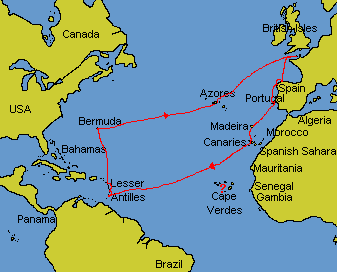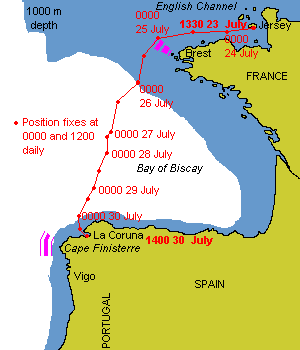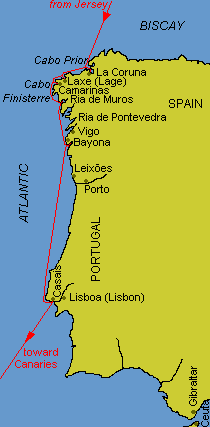
CHART
BOX

© Copyright 1999 Nigel Jones/MistWeb Software

 |
CHART |

|
|
| Sketch Maps and Chartlets (not to be used for navigation!) © Copyright 1999 Nigel Jones/MistWeb Software |
|
Rusalka Mist is in Galicia, North-West Spain. We are planning, for the next few weeks, to continue our summer cruise of the Spanish Rías.
In July 1999, both Nicky and I left our jobs. She has a one-year sabbatical from hers and I have a 'gap-year' before I become a student again (an MSc in Applied Computing at the University of Portsmouth). The plan is to complete a short Atlantic Circuit in this year.
The first step of this circuit was the crossing of the notorious Bay of Biscay. We completed this during the last week of July.
It was a hectic time - winding up our work, preparing the boat with equipment and provisions, moving on board, saying good-bye for a year to family and friends - all with the background feeling of butterflies in our stomachs concerning the Biscay crossing ahead of us. Neither of us had ever made an ocean crossing before and, at least for the purposes of an RYA Yachtmaster 'Ocean' endorsement, Biscay counts as such. The furthest we had ever sailed before was across the English Channel - about 120 Nautical Miles (NM) taking 36 hours at our slowest - this was about five times that distance and beyond all normal means of help or rescue for most of the passage. The crossing took us a full seven days in the end and we met no problem we could not overcome. (Click here for the full Biscay story on four web-pages)
 |
CHART |

|
|
| Sketch Maps and Chartlets (not to be used for navigation!) © Copyright 1999 Nigel Jones/MistWeb Software |
|
The North-West corner of Spain is an excellent cruising ground for the yachtsman. The area from La Coruña, where we arrived, around the coast towards Cabo Finisterre includes most of the Rías Altas. From the Cape down to the Portuguese border are the Rías Bajas. These Rías are more than just rivers or estuaries for us to anchor in. They are deep bays with sometimes more than one river flowing into each one from the deep-cut coastline. Here in the the Northerly Rías Altas we are in the midst of an ancient, granite landscape shaped by many millions of years of harsh erosion, and it all shows in the face of the landscape.
This is an area famous within Spain for its good food and wine. There are enough local cheeses - quesos - for a lifetime of diligent study. We have discovered the most delicious, creamy, pale soft varieties I have ever come across. Fishing is one of the main industries here and the seafood is as abundant as it is loved. A local delicacy is empanada. This is a huge, thin pastry-covered pie which can be found for sale in delicatessens, on market stalls as well as in restaurants. It can have almost any filling but seems at its best with a mixture of local sea-food layered inside it. They seem very keen on their version of a Russian Salad here (ensaladilla rusa) - the supermarkets even sell a special version of mayonnaise which has been optimised for its home-construction. In the yacht club at A Coruña it was served heavy with tuna and egg and, with the local, hard wholemeal bread, could easily have been a meal in itself.
There is a local language - Galego - which is no more difficult to deal with than pure Spanish. La Coruña becomes A Coruña, Lage becomes Laxe and Galicia itself is locally called Galega. It seems that the main purpose of the dialect is to help the locals maintain a little identity in this busy world. It is possible to tell, just by looking at the spellings of these important words, if a poster, roadsign or advertiser relates to something homespun and locally-based or if it something from outside, possibly being imposed or sold on a national basis. It is a bit of a secret handshake, perhaps, to help the locals maintain what they value.
 |
CHART |
 |
|
| Sketch Maps and Chartlets (not to be used for navigation!) © Copyright 1999 Nigel Jones/MistWeb Software |
|
You can see from the chartlet that there is not much we are planning on seeing in Portugal. This is purely because the Portuguese coast is just not so friendly to the small yacht as the Spanish happens to be. There are not the little bays and fishing harbours into which we can slip. We are in no real rush to leave the Rías and are enjoying the peace.
We should be heading well South before the Autumn sets in as we don't want to have to deal with any nasty weather when there's plenty of the lovely stuff waiting for us ahead. We are vaguely expecting to clear into Portugal early in September. Click here for the story of our travels and our life in the Rías. After Portugal we are more or less decided that we shall skip the Island of Madeira and sail directly to the Canaries to prepare for and await our departure to the Caribbean.
Until then we have to decide whether to go ashore and get some more of those delicious figs or just sit here and let another day slip by, as we look at the locals playing on the beach. Mmmmm, did I tell you about the biscuits? Campechanas, they're called, with a picture of some sugar-cane on the pack-front. Sooooo sweet! And sooooo crunchy!